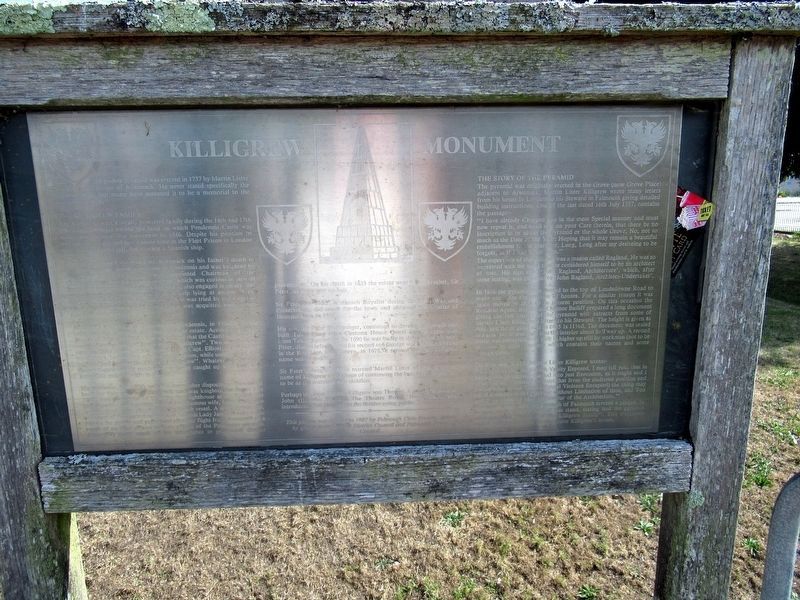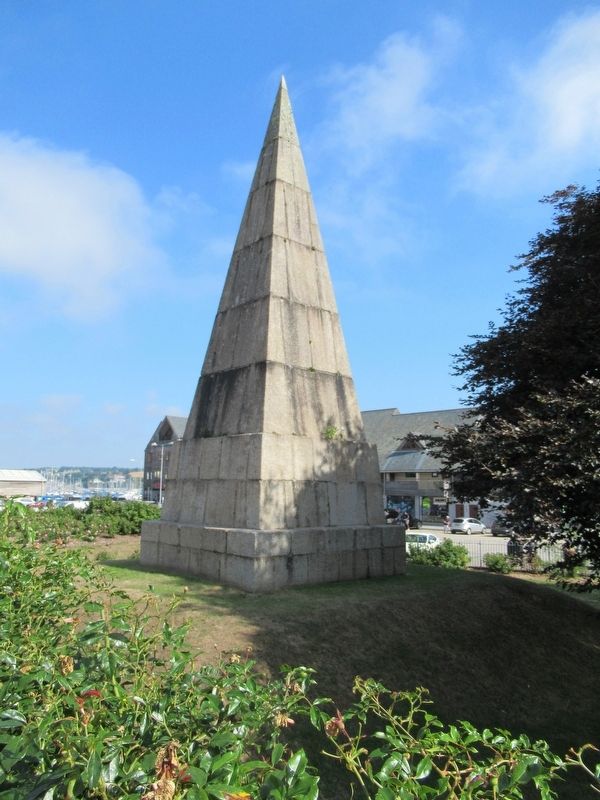Falmouth in Cornwall, England, United Kingdom — Northwestern Europe (the British Isles)
Killigrew Pyramid
The granite pyramid was erected in 1737 by Martin Lister Killigrew the owner of Arwenack. He never stated specifically the purpose of it, but many have assumed it to be a memorial to the Killigrew family.
The Killigrew Family
The Killigrew s were a locally powerful family during the 16th and 17th centuries. John (I) owned the land on which Pendennis Castle was built, and became first Governor in 1546. Despite his position he engaged in piracy and spent some time in the Fleet Prison in London with his son John (II), for looting a Spanish ship.
John (II) inherited the estate of Arwenack on his father’s death in 1567. He became second Governor of Pendennis and was knighted by Elizabeth I in 1574. He was appointed Chairman of the Commissioners for Piracy in Cornwall, which was curious in view of his period in prison. His wife, Lady Mary, also engaged in piracy. She was accused of plundering a Spanish ship lying at anchor in the harbour, and of murdering the crew. She was tried by the Court of which her husband was Chairman: she was acquitted while others involved were hanged.
John (III) also became Governor of Pendennis, in 1584. He lived extravagantly, gambled, and neglected the estate. According to State Papers of February 1598 “it was reported that the Castle of Falmouth was sold to the King of Spain by one Killigrew”. Whatever the truth of these allegations, his misdeeds eventually caught up with him, and John (III) ended his life in prison.
His successor, John (IV), was of a more sober disposition. He worked hard for Falmouth and Cornwall, and was knighted by James I in 1617. Two years later he built the first lighthouse at the Lizard. He had, however, debt problems, and an infamous wife, Lady Jane, who was involved in the plundering of a Dutch vessel. A silver loving cup, now part of Penryn’s civic treasure, records Lady Jane’s thanks to the Mayor for shelter and protection after her flight from Arwenack as a result of an illicit affair with an officer of the Pendennis garrison. John (IV) spent much of his inheritance in protracted divorce proceedings. On his death in 1633 the estate went to his brother, Sir Peter, as there was no heir.
Sir Peter the Elder, a staunch Royalist during the Civil War and Protectorate, did much for the town and obtained the Charter of Incorporation in 1651.
His son, Sir Peter the Younger continued to develop Falmouth and built Town Quay (now Customs House Quay) against opposition from Town dignitaries. By 1690 he was badly in debt. Since his heir, Peter, died in infancy and his second son, George was killed in a brawl in the Red Lion Inn, Penryn, in 1678, it seemed the Killigrew name would end here.
Sir Peter’s daughter Anne married Martin Lister who took on the name of Killigrew in the hope of continuing the line; but this was not to be as the marriage was childless.
Perhaps the most likable Killigrew was Thomas, a great grandson of John (I), who founded The Theatre Royal, Drury Lane, and introduced Nell Gwynne to the theatre going public.
The Story of the Pyramid
The pyramid was originally erected in the grove (now Grove Place) adjacent to Arwenack. Martin Lister Killigrew wrote many letters from his house in London to his Steward in Falmouth giving detailed building instructions. One of the last, dated 16th July 1737, contains the passage:
“I have already Charged you in the most Special manner and must now repeat it, and shall rely on your Care therein, that there be no Inscription in or about the pyramid or the whole Grove, No, not so much as the date or the Year: Hoping that it may remain a beautiful embellishment to the Harbour, Long, Long after my desireing to be forgott, as if I had never been.”
The supervisor of the building was a mason named Ragland. He was so impressed with his work that he considered himself to be an architect of note. His sign read ‘John Ragland, Architecture’, which, after some jesting, was changed to ‘John Ragland, Architect-Undertaker’.
In 1836 the pyramid was moved to the top of Lansdowne Road to make room for the erection of houses. For a similar reason it was again moved in 1871 to its present position. On this occasion the Resident Agent, Builder and Manor Bailiff prepared a long document giving the full history of the pyramid with extracts from some of Martin Lister Killigrew’s letters to his Steward. The height is given as 40ft, and the original cost of £455 1s 11 1/2d. the document was sealed into a glass bottle and built into the interior about half way up. A second bottle was surreptitiously built in higher up still by workmen (not to be outdone by their masters) which contains their names and some foreign coins.
On 29th March 1737 Martin Lister Killigrew wrote: “Without having my foolish Vanity Exposed, I may tell you that in having this projection Carried into just Execution as it ought and hope will be, I pretend to insist that from the sheltered position and Durableness of the State (Manual Violence Excepted) the thing may stand a beauty to the Harbour without Limitation of time, and You and You posterity have the honour of the Architecture.”
Nearly 200 years later the Borough of Falmouth erected a plaque, to be seen on the reverse side of this stand, stating that the pyramid “commemorates the last of the Killigrew family”. This statement cannot be inferred from Martin Lister Killigrew’s letters. ( ed. note: this plaque is missing )
This plaque was erected in 1987 by Falmouth Civic Society, aided by grants from Carrick District Council and Falmouth Town Council
Erected 1987 by Falmouth Civic Society.
Topics. This historical marker is listed in this topic list: Industry & Commerce.
Location. 50° 9.038′ N, 5° 3.797′ W. Marker is in Falmouth, England, in Cornwall. Marker is at the intersection of Avenue Road and Campbeltown Way, on the right when traveling north on Avenue Road. Touch for map. Marker is in this post office area: Falmouth, England TR11 3XP, United Kingdom. Touch for directions.
Other nearby markers. At least 8 other markers are within walking distance of this marker. National Maritime Museum Cornwall (about 120 meters away, measured in a direct line); Discovery Quay (about 120 meters away); Russian Convoy Memorial (about 120 meters away); HMS Forte IV (about 150 meters away); The Port of Falmouth (approx. 0.3 kilometers away); Falmouth Docks (approx. 0.7 kilometers away); Pendennis Point (approx. 1.5 kilometers away); Watching the waterline (approx. 1.6 kilometers away). Touch for a list and map of all markers in Falmouth.
Credits. This page was last revised on January 27, 2022. It was originally submitted on September 29, 2018, by Michael Herrick of Southbury, Connecticut. This page has been viewed 440 times since then and 43 times this year. Photos: 1, 2. submitted on September 29, 2018, by Michael Herrick of Southbury, Connecticut.

